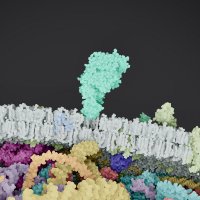
Nicholas Sofroniew
@sofroniewn
EvolutionaryScale
ID: 2911279295
http://sofroniew.com 08-12-2014 17:48:57
5,5K Tweet
2,2K Takipçi
1,1K Takip Edilen










Great AI meets Bio event in Boston with Michael Koeris george church and Alex Rives 🧬🧬🧬🔥🔥🔥

Have you ever wanted to design protein binders with ease? Today we present 𝑩𝒊𝒏𝒅𝑪𝒓𝒂𝒇𝒕, a user-friendly and open-source pipeline that allows to anyone to create protein binders de novo with high experimental success rates. Bruno Correia Sergey Ovchinnikov biorxiv.org/content/10.110…






We're thrilled to present ESM3 in Science Magazine. ESM3 is a generative language model that reasons over the three fundamental properties of proteins: sequence, structure, and function. Today we're making ESM3 available free to researchers worldwide via the public beta of an API










